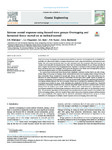Extreme coastal responses using focused wave groups: Overtopping and horizontal forces exerted on an inclined seawall
| dc.contributor.author | Whittaker, CN | |
| dc.contributor.author | Fitzgerald, CJ | |
| dc.contributor.author | Raby, Alison | |
| dc.contributor.author | Taylor, PH | |
| dc.contributor.author | Borthwick, Alistair | |
| dc.date.accessioned | 2018-08-31T13:51:57Z | |
| dc.date.issued | 2018-10 | |
| dc.identifier.issn | 0378-3839 | |
| dc.identifier.issn | 1872-7379 | |
| dc.identifier.uri | http://hdl.handle.net/10026.1/12216 | |
| dc.description.abstract |
Total wave group overtopping and maximum horizontal force responses are investigated for an idealised seawall/dike on a plane beach subject to compact focused wave attack, using both laboratory and numerical wave flumes. The wave group interactions have very short durations such that extraneous reflections from the wavemaker arrive long after the main interaction. These short test durations facilitate the use of large ensembles of tests to explore the sensitivity of overtopping and force responses to variations in focus location, phase angle at focus, and linear focus wave amplitude. The scope of the laboratory wave flume tests is broadened by accurate numerical simulation based on a 1DH hybrid Boussinesq-NLSW model. For a given focus location and linear focused wave amplitude, variations in phase lead to an order-of-magnitude change in the group overtopping volume. Substantial increases in overtopping volume owing to the use of linear wavemaker theory (compared to second order theory) are also observed. These observations have implications for phase-independent empirical relationships derived using linear paddle signals in physical experiments. Examination of the incidence of wave groups parametrically optimised for maximum (and minimum) overtopping volumes indicates that the overtopping volume may be optimised by minimising reflections of pre-overtopping waves within the group, while maximising the amplitude of the first overtopping bore. Numerical predictions of horizontal seawall forces are obtained using fluid impulse derivatives and hydrostatic pressures obtained from the shallow water model. Within the shallow water model framework, hydrodynamic force contributions included in the fluid impulse method are observed to be small relative to the hydrostatic pressure force. The parametric dependence of the horizontal (non-impulsive) forces on the seawall is very similar to that of the overtopping volumes, with clear ‘bands’ of large values observed as a function of phase and focus location (for a given amplitude). This suggests that the parametric optimisation of focused wave groups is a robust method for the investigation of multiple coastal responses such as overtopping, forces and runup. | |
| dc.format.extent | 292-305 | |
| dc.language | en | |
| dc.language.iso | en | |
| dc.publisher | Elsevier | |
| dc.subject | Overtopping | |
| dc.subject | Seawall | |
| dc.subject | Forces | |
| dc.subject | Focused wave groups | |
| dc.subject | Wave-maker theory | |
| dc.subject | Spurious error wave | |
| dc.subject | Boussinesq numerical wave tank | |
| dc.subject | Extreme waves | |
| dc.title | Extreme coastal responses using focused wave groups: Overtopping and horizontal forces exerted on an inclined seawall | |
| dc.type | journal-article | |
| dc.type | Journal Article | |
| plymouth.author-url | https://www.webofscience.com/api/gateway?GWVersion=2&SrcApp=PARTNER_APP&SrcAuth=LinksAMR&KeyUT=WOS:000447101300020&DestLinkType=FullRecord&DestApp=ALL_WOS&UsrCustomerID=11bb513d99f797142bcfeffcc58ea008 | |
| plymouth.volume | 140 | |
| plymouth.publication-status | Published | |
| plymouth.journal | Coastal Engineering | |
| dc.identifier.doi | 10.1016/j.coastaleng.2018.08.004 | |
| plymouth.organisational-group | /Plymouth | |
| plymouth.organisational-group | /Plymouth/Admin Group - REF | |
| plymouth.organisational-group | /Plymouth/Admin Group - REF/REF Admin Group - FoSE | |
| plymouth.organisational-group | /Plymouth/Faculty of Science and Engineering | |
| plymouth.organisational-group | /Plymouth/Faculty of Science and Engineering/School of Engineering, Computing and Mathematics | |
| plymouth.organisational-group | /Plymouth/REF 2021 Researchers by UoA | |
| plymouth.organisational-group | /Plymouth/REF 2021 Researchers by UoA/UoA12 Engineering | |
| plymouth.organisational-group | /Plymouth/Users by role | |
| plymouth.organisational-group | /Plymouth/Users by role/Academics | |
| plymouth.organisational-group | /Plymouth/Users by role/Researchers in ResearchFish submission | |
| dcterms.dateAccepted | 2018-08-02 | |
| dc.rights.embargodate | 2019-12-18 | |
| dc.identifier.eissn | 1872-7379 | |
| dc.rights.embargoperiod | Not known | |
| rioxxterms.funder | Engineering and Physical Sciences Research Council | |
| rioxxterms.identifier.project | ENFORCE - Extreme responses using NewWave: Forces, Overtopping and Run-up in Coastal Engineering | |
| rioxxterms.versionofrecord | 10.1016/j.coastaleng.2018.08.004 | |
| rioxxterms.licenseref.uri | http://www.rioxx.net/licenses/all-rights-reserved | |
| rioxxterms.licenseref.startdate | 2018-10 | |
| rioxxterms.type | Journal Article/Review | |
| plymouth.funder | ENFORCE - Extreme responses using NewWave: Forces, Overtopping and Run-up in Coastal Engineering::Engineering and Physical Sciences Research Council |


